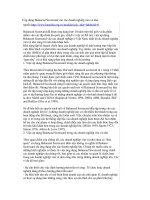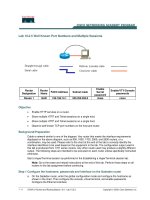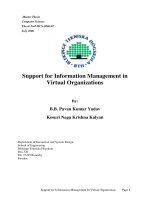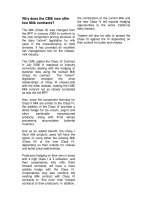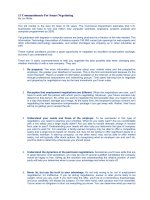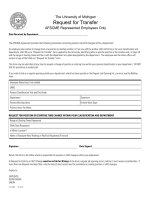Tài liệu Primer For Class Iii & Class Iv Milk Futures And Options Traders(pdf) pptx
Bạn đang xem bản rút gọn của tài liệu. Xem và tải ngay bản đầy đủ của tài liệu tại đây (55.39 KB, 15 trang )
Why does the CME now offer
two Milk contracts?
The Milk (Class III) was changed from
the BFP in January 2000 to conform to
the new component pricing structure of
the dairy "reform" legislation for milk
used in the manufacturing of hard
cheeses. It has provided an excellent
risk management tool for the cheese-
milk industry.
The CME added the Class IV Contract
in July 2000 in response to industry
comments dealing with the hedging of
butterfat risks using the revised Milk
(Class III) contract. The "reform"
legislation changed the price
relationships of Class III cheese-milk
with the other classes, making the CME
Milk contract not as closely correlated
as was the old BFP.
Also, since the component formulas for
Class II Milk are similar to the Class IV,
the addition of the Class IV provides a
direct hedge for ice cream, yogurt and
other perishable manufactured
products, along with firms whose
processing accumulates butterfat
inventory.
And as an added benefit, the Class I
(fluid milk product) users will have the
option of using either the existing Milk
(Class III) or the new Class IV,
depending on their outlook for cheese
and butter price relationships.
Producers hedging on their own in areas
with a high Class I & II utilization, and
their cooperatives who offer them
forward contracts, will have a more
reliable hedge with the Class IV.
Cooperatives may also combine the
existing Milk contract with Class IV
contracts to "fine tune" their forward
contracts to their producers. In addition,
the combination of the current Milk and
the new Class IV will expand hedging
opportunities to the entire California
dairy industry.
Traders will also be able to spread the
Class III against the IV depending on
their outlook for butter and cheese.
How does the Milk Class III price relate to the historical price
information of the BFP?
The CME “Milk” contract replaced the “BFP Milk” contract in January 2000, to
properly reflect the price of milk used in the manufacturing of cheese under the
revised government federal pricing classification system for all uses of milk. The
CME Milk contract is cash settled (monthly) to the Class III National Agricultural
Statistics Service (NASS) announced price, released no later than the fifth day of
following month. All other aspects of trading the contract remain the same.
1 Consult your broker for additional information or specific requirements, policies and procedures.
2 Trading times may vary; consult the CME for holiday schedule.
Class III Monthly Averages and Ranges,
1995 to 2000
8.50
10.30
12.10
13.90
15.70
17.50
($/cwt.)
Hi
16.27 13.32 12.81 13.09 13.77 13.92 14.77 15.79 16.26 16.04 16.84 17.34
Lo
10.05 9.54 9.54 9.41 9.37 9.46 10.66 10.13 10.76 10.02 8.57 9.37
Avg
12.60 11.66 11.84 11.49 11.18 11.68 12.60 13.25 13.73 12.85 12.11 12.31
Jan Feb Mar Apr May Jun Jul Aug Sep Oct Nov Dec
Why have milk prices become so volatile?
The lowering of price supports by the government, along with increased demand,
mainly for cheese and cheese products, have brought about a price equilibrium
between the supply of milk and the uses of milk. Thus, any seasonal changes in the
production or demand for milk and milk products create volatile price swings.
Milk Production vs. Commercial Consumption
105
119
133
147
161
175
(billion lbs.)
Production
115 120 123 121 123 128 133 136 140 135 143 143 143 144 148 148 151 151 154 155 154 156 157 163 168
Commercial Use
114 116 116 119 120 119 120 122 122 127 130 133 136 135 139 139 141 145 150 155 155 157 160 165 169
75 76 77 78 79 80 81 82 83 84 85 86 87 89 90 91 92 93 94 95 96 97 98 99 00
0.0
5.0
10.0
15.0
20.0
25.0
30.0
pounds, except fluid milk, which is in gallons
Milk & cream
(gal)
Butter Amer. cheese Non-American
Cheese
Total cheese Cottage
cheese
Ice cr eam Lowf at ice
cream
NFDM Whey
Per-capita consumption, 1980 vs. 1999
1980
1999
How does the new Class IV relate to the CME Milk Class III
contract?
The simplest answer is to define the pricing structure of the two classes of milk. The
Class III is milk used in hard cheeses and the Class IV is milk used for butter and
dried milk products. A more complex answer would define the method derived by
the USDA’s NASS Agency in calculating the pricing formulas for the two classes of
milk. (See both USDA NASS release dates and formulas at the back of Primer). Of
significance (to both hedgers and traders) is the price relationship of the major milk
component of cheese (protein) which constitutes Class III pricing and butter
(butterfat), which constitutes Class IV pricing.
Class III vs. Class IV
10.50
11.20
11.90
12.60
13.30
14.00
JFMAMJJASOND
($/cwt.)
Class III Class IV
How is the Class III Milk price established?
NASS conducts weekly industry-wide surveys on cheese, whey, and butter cash
transactions. These prices are volume-weighted and incorporated into a pricing
formula to determine the monthly Class III price for milk with 3.5% butterfat. On
Friday of each week, the USDA reports the changes in the average prices from the
prior week. Both traders and hedgers can monitor this information to gain insight as
to the final cash settled price.
How is the Class IV Milk price established?
NASS uses weekly industry-wide surveys on butter, whey, and nonfat dry milk cash
transactions. These prices are volume-weighted and incorporated into a pricing
formula to determine the monthly Class IV price for milk with 3.5% butterfat. On
Friday of each week, the USDA reports the changes in the average prices from the
prior week. Both traders and hedgers can monitor this information to gain insight as
to the final cash settled price.
What are the classifications of Milk?
Class I
Milk used to produce fluid milk products, such as bottled milk.
Class II
Milk used to produce soft manufactured dairy products such as cottage
cheese, ice cream and yogurt.
Class III
Milk used to produce cream cheese and hard manufactured cheese. This is
the type of milk reflected in the CME milk contract.
Class IV
Milk used to produce butter and all dried milk products. This is the type of
milk reflected in the CME Class IV contract.
How to Trade CME Milk Futures Contracts –
(Reference Class III or Class IV Futures Contract Specifications)
The following examples and illustrations of “How to Trade Futures Contracts”, “How
to Trade Milk Options”, “Hedging CME Milk Futures” and “Hedging with CME Milk
Options” relate to both the CME’s Milk (Class III) contract and the new Class IV.
Likewise, the principles are the same for Buy/Sell hedgers pricing Class I milk, using
either of the two contracts.
Benefits
The CME Milk futures and options contracts offer easy entry into futures and options
markets. The Milk futures and options contracts trade each month, can be offset at
any time, or can be held through contract expiration and be automatically offset at
the USDA’s announced price for Class III and IV Milk.
What is a Futures Contract?
A futures contract is a legally binding obligation to buy or sell a commodity that
meets set grades and standards on some future date.
Type of Positions Price Advantage In: To Offset Position
1
Sell = Short Down Markets Buy Back Contract
(Loses in up markets)
Buy = Long Up Markets Sell Back Contract
(Loses in down markets)
Futures Example: Buy low/sell high, or vice versa
As a speculator, if you think prices are going higher, then you would buy Milk
futures. If you think prices are moving lower, then you would sell Milk futures. To
close out or offset your trade, take the opposite position.
1
All futures contracts require a fulfillment, or binding obligation, on the part of the trader at some time before the contract
expires. Traders of the Milk contract may fulfill contract obligations by offsetting in the futures market (entering an opposite
trade order) any time prior to contract expiration, or by accepting an automatic offset at the Class III announced price on the
date of the announcement.
